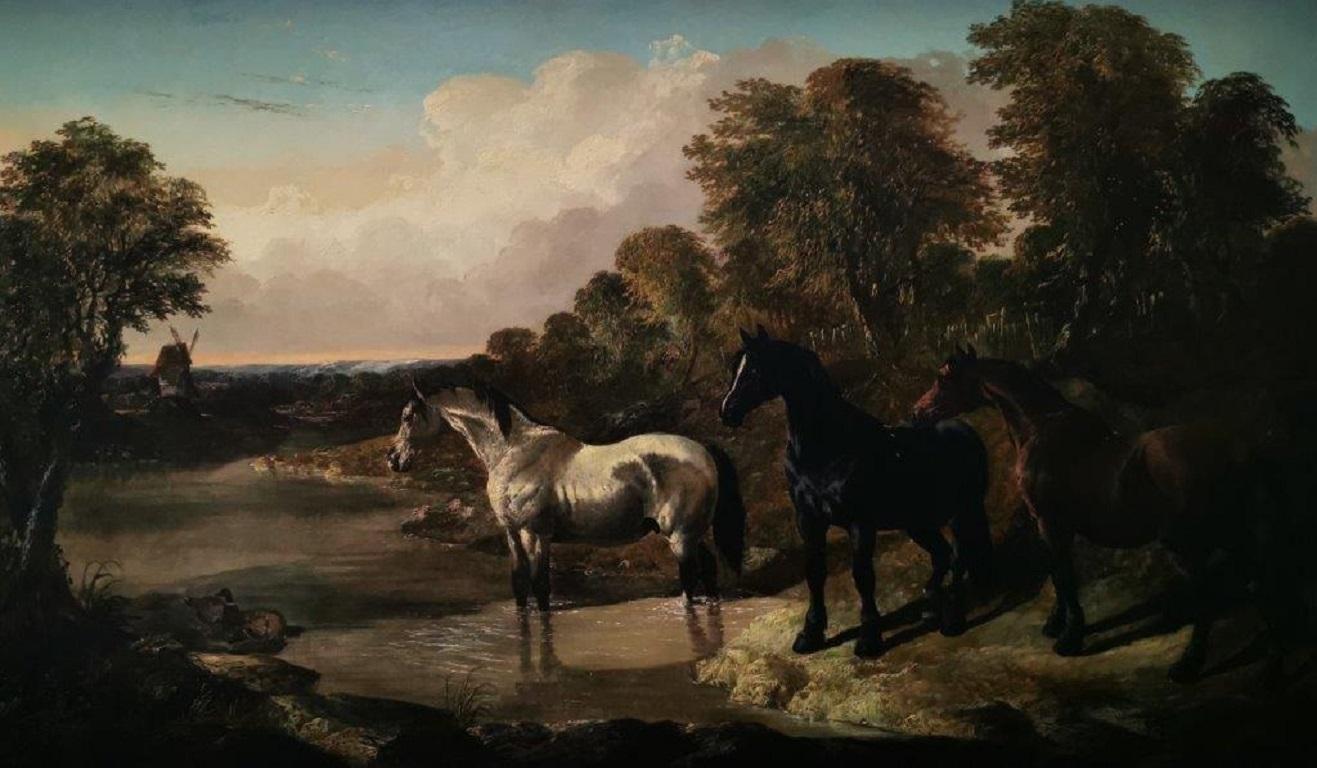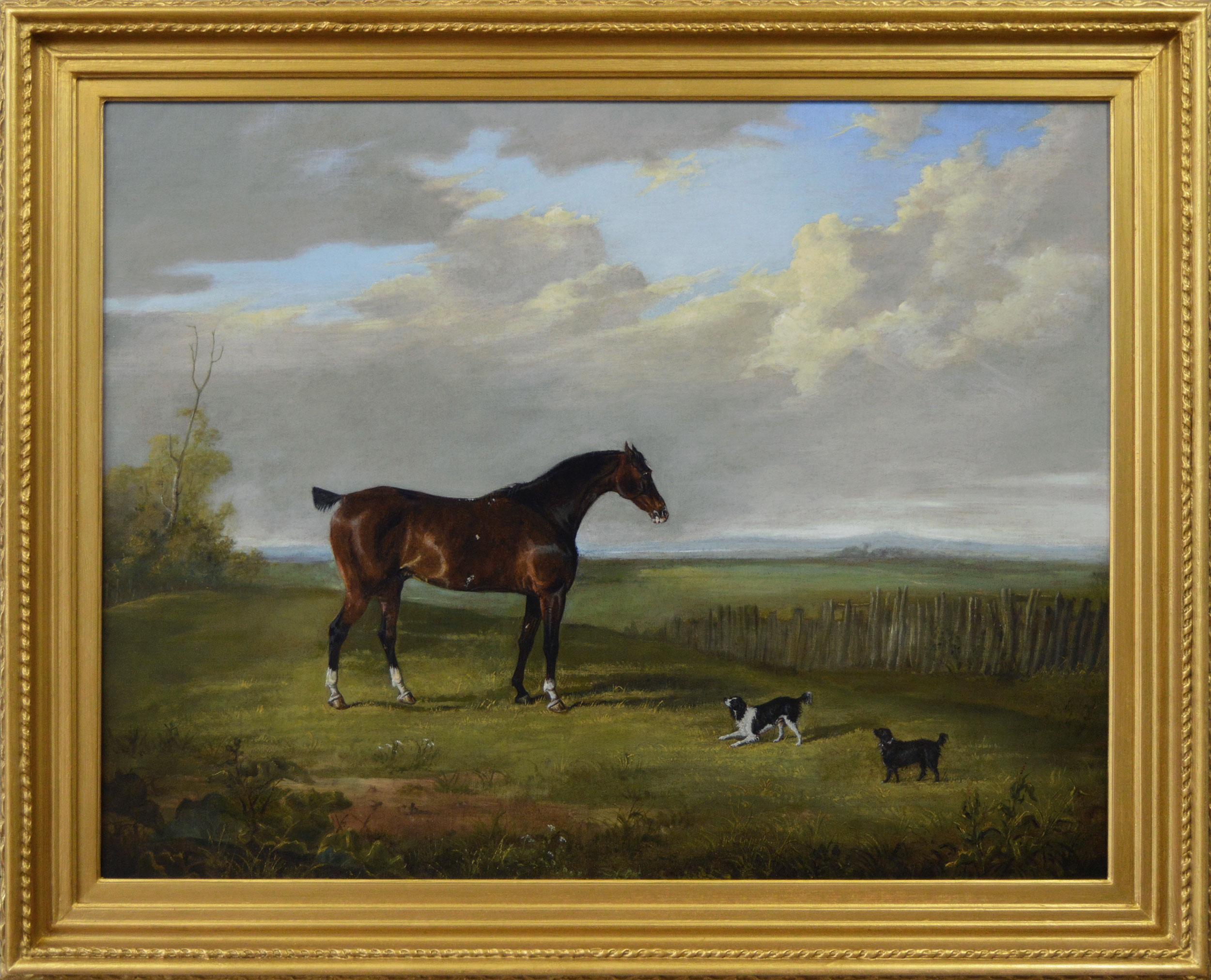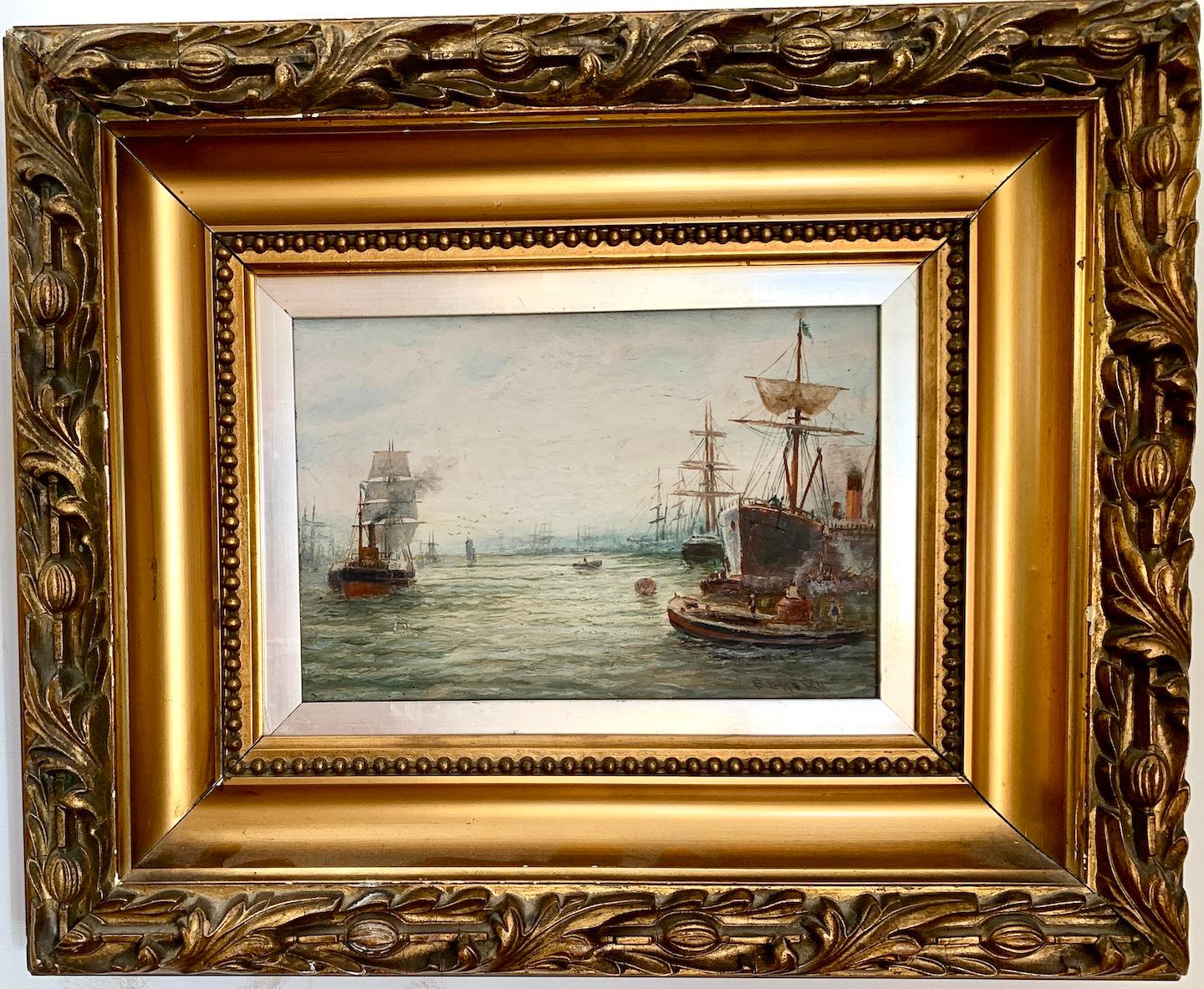Items Similar to Making the Run for Home, Cornish Coast. Cornwall. Sail Fishing Boat. Pilchards.
Want more images or videos?
Request additional images or videos from the seller
1 of 24
Charles Napier HemyMaking the Run for Home, Cornish Coast. Cornwall. Sail Fishing Boat. Pilchards.1915
1915
About the Item
Charles Napier Hemy.
English ( b.1841 – d.1917 ).
Making the Run for Home, Cornish Coast. 1915
Oil on Canvas.
Monogram & dated 1915 lower right.
Image size 19.5 inches x 29.5 inches ( 49.5cm x 75cm ).
Frame size 25.6 inches x 35.6 inches ( 65cm x 90.5cm ).
Available for sale; this original oil painting is by the marine artist Charles Napier Hemy and is dated 1915.
The painting is presented and supplied in a sympathetic frame and mount dating from the 1960s or 1970s.
The painted surface and canvas have been restored and cleaned whilst in previous ownership. The canvas is lined. We are of the opinion that this work was performed in the 1960s or 1970s and correlates with the frame’s age.
Today, this antique painting is in good condition as a result of the previous work. It is supplied ready to hang and display.
The painting is signed and dated lower right.
Charles Napier Hemy, possibly the finest British marine artist of his generation, is known for his works in the Tate collections. He had a life that was particularly interesting, fulfilling and professionally successful.
He was born at Newcastle upon Tyne on 24 May 1841, the eldest son of a composer. His two younger brothers also became artists, although neither achieved the success of Charles.
In 1850 his parents had run into financial difficulties, so the Hemys emigrated to Australia, aboard a ship named the Madawaska. His mother gave birth to his youngest brother whilst on the journey. For Charles, then just a nine-year-old boy, this was an epic voyage and the return voyage in 1852 marked the start for him of a love affair with boats and the sea: He later wrote “It was imprinted on my mind and I never forgot it”. Whilst in Australia Charles’ father tired his hand at gold prospecting, assisted by young Charles, but the family found it the life very tough, especially with three young boys, and so they returned to England. The small amount of gold they had prospected however enabled them to settle their debts and resume a decent life.
Charles had a strong artistic interest, and at 13 he enrolled in Newcastle’s Government School of Design under the tutelage of William Bell Scott. During his teenage years Charles also worked briefly on the sea, with two stints sailing on merchant vessels.
Charles was a deeply spiritual man and a lifelong and devout Catholic. In the mid 1850s he decided to enter the priesthood and spent three years as a monk in a Dominican House, at Newcastle upon Tyne, and in a monastery in Lyons, France. He painted in his spare time, working on church decorations. This love of painting caused him to reconsider life as a priest and, rather than taking his final vows, he took up painting professionally. He went to Antwerp and studied under H Leys from 1867-1870, where he painted historical scenes. In 1870 he settled in London, where he was much influenced by Whistler. From 1870-80 he worked from a studio in Fulham and in the William Morris workshop, where he was greatly influenced by the Pre-Raphaelite movement. As Charles began to support himself as an artist, he changed his name to Charles Napier Hemy, choosing the additional name because his mother was an admirer of her cousin Sir Charles Napier.
Charles Hemy became a much respected artist and part of the established art scene of his day. His painting ‘Pilchards’ was purchased for the Chantry Bequest in 1897. He first exhibited at the Royal Academy in 1869 and continued to do so throughout his life. He was elected an Associate of the Royal Academy in 1869 and elected a full member in 1910. He was also a member of the Royal Watercolor Society and the Royal Institute.
Charles married Mary Ann Lloyd in 1866, but she sadly died in 1880, without children. For many years Charles had spent summers in Cornwall and later in 1880 he settled in Falmouth, where he was to spend the rest of his life devoted to marine painting. He later remarried, a local Falmouth girl, Amy Freeman and they went on to have ten children. He built his home, Churchfield, to his own design and specification and his commercial success as a major artist enabled him to provide a very comfortable lifestyle for his large family.
Charles was an ardent yachtsman and fitted out his own yacht, the Vanderveld, as a studio. Writing to a friend he explained “I have built my house here (Falmouth) so as to paint nothing but sea and ships and do them always from nature. It is sad not to be in London, but I think Falmouth is better than Venice”. He would follow other boats out to sea in his yacht and made sketches of them, then complete the work from Churchfield. His paintings from this period show a broad, swirling style, reflecting his intimate knowledge and love of the sea. In Falmouth Hemy became mentor to Sir Frank Brangwyn and the renowned marine painter, Montague Dawson. He was also a close friend of Henry Scott Tuke, who had helped found the Newlyn School. Hemy was therefore very much part of the prospering Cornish art scene of the time, being regarded as one of its elder statesmen.
Hemy continued to paint and sail right up until his death at Falmouth on 30 September 1917. He is buried in the Dissenters’ plot in Falmouth Cemetery in the Dominican monk’s habit that he had kept from his early 20s and not far from his friend Henry Scott Tuke. An exhibition of his work, with a catalogue, was held at the Laing Art Gallery, Newcastle-upon-Tyne, in 1984.
There are many examples of his work in public collections, including the Walker Art Gallery, Liverpool, the Tate, London, the Laing Art Gallery, Newcastle upon Tyne, the Greenwich Art Gallery and the National Gallery of New South Wales, Sydney.
© Big Sky Fine Art
This magnificent original oil on canvas painting by Charles Napier Hemy is called ‘Making the Run for Home’ and is signed and dated to the lower right. It depicts a small wooden sailing vessel with a full sail on its single mast, a smaller sail on the stern, skimming over the waves as it makes its way home. We view the port side of the vessel as if from the water, the bow to the left, with the vessel travelling towards us. The three male figures on board wear oilskins and sou’westers, the traditional clothing of local fishermen. There are four seagulls following the boat. The weather is blustery but fine; the sky above has light cloud. The sea, sparking in shades of blue and aquamarine is lively with bright splashes of spray. This painting demonstrates Hemy’s mastery of his subject and ability to convey the feeling of the wind and sea.
- Creator:Charles Napier Hemy (English)
- Creation Year:1915
- Dimensions:Height: 25.6 in (65 cm)Width: 35.63 in (90.5 cm)Depth: 2.96 in (7.5 cm)
- Medium:
- Movement & Style:
- Period:
- Condition:The painted surface and canvas have been restored and cleaned whilst in previous ownership. The canvas is lined. Today, this antique painting is in good condition as a result of the previous work. It is supplied ready to hang and display.
- Gallery Location:Sutton Poyntz, GB
- Reference Number:1stDibs: LU489313970692
About the Seller
5.0
Gold Seller
These expertly vetted sellers are highly rated and consistently exceed customer expectations.
Established in 2010
1stDibs seller since 2016
111 sales on 1stDibs
Typical response time: 1 hour
- ShippingRetrieving quote...Ships From: Sutton Poyntz, United Kingdom
- Return PolicyA return for this item may be initiated within 14 days of delivery.
More From This SellerView All
- The Approaching Gale on The Scheldt Estuary, 1877. Belgian Dutch North Sea CoastBy Arthur Joseph MeadowsLocated in Sutton Poyntz, DorsetArthur Joseph Meadows. English ( b.1843 - d.1907 ). The Approaching Gale on The Scheldt Estuary, 1877. Oil on Canvas. Signed. Image size 17.3 inches x 31.5 inches ( 44cm x 80cm ). ...Category
Mid-19th Century Victorian Landscape Paintings
MaterialsCanvas, Oil
- Streatley Mill, River Thames, near Goring, Oxfordshire. Substantially Framed.By Alfred de Breanski Jnr.Located in Sutton Poyntz, DorsetAlfred Fontville II De Breanski Jnr. English ( b.1877- d.1957 ). Streatley Mill, River Thames, near Goring, Oxfordshire. Oil on Canvas. Signed lower left. Image size 11.4 inches x 15...Category
Early 20th Century Victorian Landscape Paintings
MaterialsCanvas, Oil
- Worm’s Head (Pen Pyrrod), Gower Peninsula. Rhossili. Swansea Bay. South Wales.By Elin Sian BlakeLocated in Sutton Poyntz, DorsetElin Siân Blake. Welsh ( b.1981). Worm’s Head (Pen Pyrrod), Gower Peninsula. Oil on canvas. Signed lower left. Image size 9.5 inches x 11.4 inches ( 24cm x 29cm ). Frame size 14.2 i...Category
21st Century and Contemporary Realist Landscape Paintings
MaterialsCanvas, Oil
- Niagara Falls, Ontario. View Across to New York State. Buffalo NY in Distance.Located in Sutton Poyntz, DorsetAlexandre Le Bihan. French ( b.1839 - d.1924 ). Niagara Falls. Oil on Canvas. Signed. Image size 23.2 inches x 49.2 inches ( 59cm x 125cm ). Frame size 28.9 inches x 55.1 inches ( 7...Category
Late 19th Century Realist Landscape Paintings
MaterialsCanvas, Oil
- Fishing Boats in St Ives Harbor, Cornwall. Luggers. Pilchards. Mackerel.PilchardLocated in Sutton Poyntz, DorsetGrant Tyson Reynard. American ( b.1887-1968 ). Fishing Boats in St Ives Harbor, Cornwall Oil on Canvas Board. Signed lower left. Image size 11 inches x 15.6 inches ( 28cm x 39.5cm ). Frame size 14.2 inches x 18.1 inches ( 36cm x 46cm ). Available for sale; this original oil painting is by the American artist Grant Tyson Reynard and dates from the period between 1912 and 1925. The painting is presented and supplied in a sympathetic contemporary frame (which is shown in these photographs), and behind premium anti-reflective glass with UV Protection greater than 70% (Artglass AR 70™). The painted surface has benefitted from cleaning and conservation, which was performed on our instruction, supervision and approval. This antique painting is in very good condition, commensurate with its age. It wants for nothing and is supplied ready to hang and display. The painting is signed lower left. Grant Tyson Reynard was an accomplished American who gained an international reputation as a painter, printmaker, teacher and writer. He was born in Grand Island, Nebraska 20th October 1887 to Stephen Blackstone and Jennie Lynd Reynard. His father ran a music store and was also the manager of the Grand Island Opera House. As a youngster Grant would sketch the well-known people who visited the community. He had an early appreciation of music, sang well and originally trained as a pianist. However, he chose to pursue a career in the visual arts, studying at the Art Institute of Chicago, 1906-7, working in the days and studying at night, and then the Chicago Academy of Fine Arts 1908-1911. In 1914 he moved to New Jersey to become a freelance illustrator, and attended summer classes in illustration organised by Harvey Dunn. It was here that he also met and became lifelong friends with John Steuart Curry, Charles Chapman, Mahonri Young and Harry Wickey, all prominent artists. He maintained a studio at Leonia, New Jersey for many years. He quickly established himself as a top illustrator, contributing to major publications of his day, including Rednook Magazine (where he was also the Art Editor), The Saturday Evening Post, Harper’s Bazaar, Collier’s, Ladies’ Home Journal, Country Gentleman, McCalls and Cosmopolitan. His increasing interest in painting and etching took him to the chief centres of study in Europe, especially Paris and London. From 1926 through to 1937 he was a fellow of the MacDowell colony in Petersborough, New Hampshire. Reynard was elected a member of the National Academy of Design and the American Watercolor Society. He was the president of the Montclair Art Museum, and served six years on the faculty of the Grand Central School of Art, New York. He also conducted the Department of Art at Millbrook School, Millbrock, New York, and was artist-in-residence at Palo Duro School of Art in Texas. In 1955 Baldwin-Wallace College awarded him an honorary Doctor of Humane Letters (LHD). Over the years Reynard’s focus shifted from illustration work to his own creative work, but in addition to producing his own art he also lectured in art and taught at several difference schools. Although he travelled extensively he remained loyal to his roots, returning to Nebraska every summer to conduct lectures and art classes in Omaha, Lincoln, Grand Island, Kearney and North Platte. In 1941 Reynard published a book of his poems “Rattling Home for Christmas” which he also illustrated. He remained deeply involved in music, always being a skilled pianist, as well as literature, and his prints often depicted concert halls and museums. Grant Reynard...Category
Early 20th Century American Impressionist Landscape Paintings
MaterialsCanvas, Oil
- Toulon, Le Port, La Vieille Darse, Mai 1939. France. 4 Months Before WWII. LokreLocated in Sutton Poyntz, DorsetLokre. 20ème siècle Toulon, Le Port, La Vieille Darse, Mai 1939 Oil on Canvas. Signed lower left. Image size 25.4 inches x 19.5 inches ( 64.5cm x 49.5cm ). Frame size 26.8 inches x ...Category
Mid-20th Century French School Landscape Paintings
MaterialsCanvas, Oil
You May Also Like
- "A River Landscape with Wild Horses", Victorian original, oil on canvasBy John Frederick Herring JrLocated in Nutfield, SurreyThis is an original unique oil painting by the artist. Born into an artistic family in Doncaster, England during 1820. Best known for his equine art, of the same character as those of the elder Herring, including "The Home Farm," "The Homestead," "The Farm-Yard," etc.John F. Herring, Jr. was born in Doncaster, South Yorkshire c.1820, to the well-known 19th-century artist John Frederick Herring, Sr. (1795-1865), who at the time, was considered one of England's great Sporting and Equestrian artists, patronized by the English aristocracy. The father's mastery of the brush, and popularity with the nobility, served his son, Herring, Jr., well. Early on, John, Jr. was exposed to fine painting and wealthy patrons. Recent reference books state that Herring, Sr.'s first child was named "John Frederick Herring, Jr." and was born on June 21, 1815. John Herring, Jr. developed a love for painting, a passion also shared by his brothers Charles and Benjamin. Three of the four brothers became artists, painting in the same style as their father, often collaborating on a single painting. In the years after 1836, Herring, Sr., feeling threatened by the teenage John Herring, Jr.'s ability and growing popularity, began incorporating the tag "SR" at the end of his signature. John Herring, Jr. continued painting in the tradition of his father, the sporting and animal pictures...Category
19th Century Victorian Landscape Paintings
MaterialsCanvas, Oil
- 19th Century landscape oil painting of geese in a Nottinghamshire cornfieldLocated in Nr Broadway, WorcestershireArthur Walker Redgate British, (1860-1906) Wilford Hill Oil on canvas, signed, further inscribed verso Image size: 15.25 inches x 25.25 inches Size including frame: 21.25 inches x 3...Category
19th Century Victorian Landscape Paintings
MaterialsCanvas, Oil
- 19th Century sporting horse portrait oil painting of a racehorse with spanielsBy George Henry LaporteLocated in Nr Broadway, WorcestershireGeorge Henry Laporte British, (1802-1873) Best of Friends Oil on canvas, signed & indistinctly dated Image size: 27.25 inches x 35.25 inches Size...Category
19th Century Victorian Animal Paintings
MaterialsCanvas, Oil
- 19th century English marine, The Thames at the Pool of London, original frameBy Bernard Benedict HemyLocated in Woodbury, CTBernard Hemy - Bernard Benedict Hemy (1844 - 1910). Marine and Coastal painter in oil and watercolor. Born in Newcastle to Henry F. Hemy, brother...Category
1890s Victorian Landscape Paintings
MaterialsCanvas, Oil
- 19th Century townscape oil painting of BrugesBy Jacques François CarabainLocated in Nr Broadway, WorcestershireJacques François Carabain Belgian, (1834-1933) Market Day, Bruges Oil on canvas, signed & dated (18)58 Image size: 28.5 inches x 35.5 inches...Category
19th Century Victorian Landscape Paintings
MaterialsCanvas, Oil
- English 19th century forest landscape with horses in the New Forest Hampshire UKBy William BradleyLocated in Woodbury, CTEnglish landscape painter from the 1870's who exhibited at the Royal Academy and the British Institute in London. He mostly painted in watercolors and this example would have been p...Category
1860s Victorian Landscape Paintings
MaterialsOil, Canvas
Recently Viewed
View AllMore Ways To Browse
French Boats Ships
Boats For Sale
Sale Boat Art
For Good Weather
Small Boat Paintings
Home Port
Used Canvas Sails
Antique Sail
Antique New England Homes
Sail Boat Art
Antique Art Australia
New England Coast
Cornish Paintings
Scott West
Oil Landscape Cornwall
Cornish Artist
Blue Sails
Australian Landscape Original Paintings





